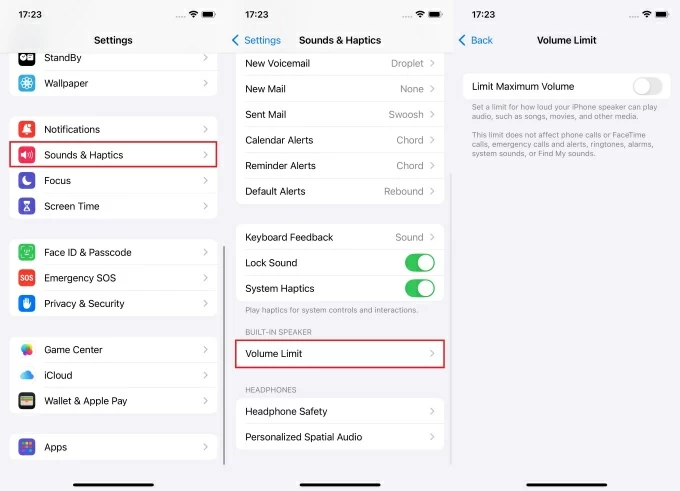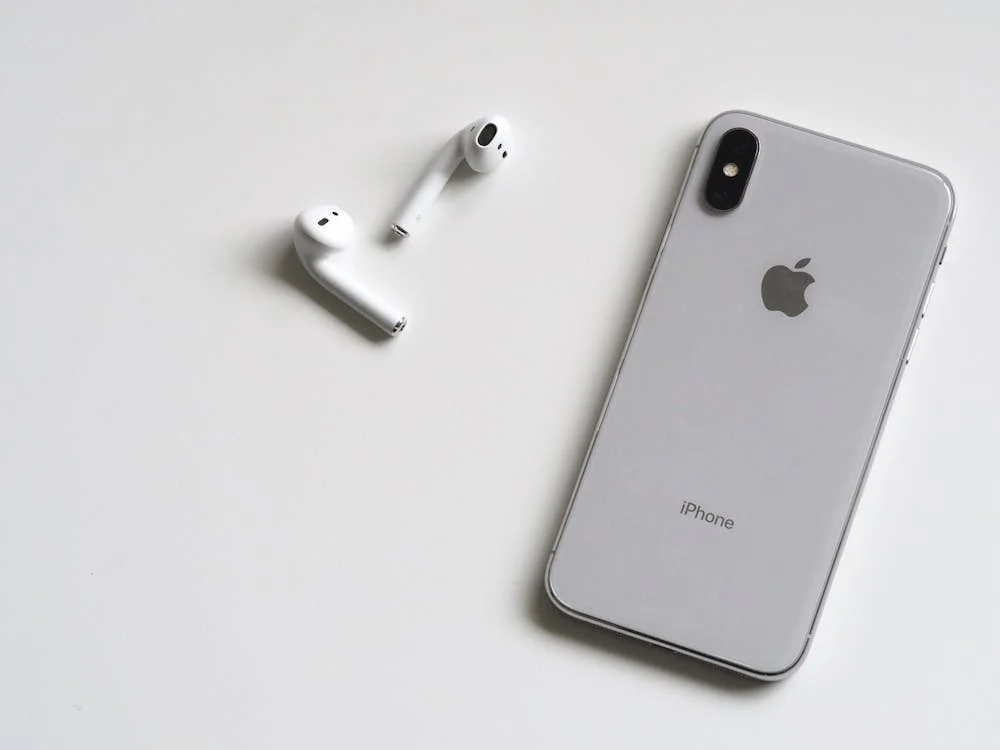Ever tried recording a video on your iPhone, only to be haunted by wind noise, muffled voices, or—worst of all—your own breathing? We get it. That’s why we’ve tested and compared the top microphones for iPhones to help you ditch those audio struggles and start sounding like a pro. Whether you’re vlogging, podcasting, or filming on the go, we’ve got the perfect mic for you.
Why Trust Us?
As the official blog of Hollyland—an industry-leading brand in wireless audio—we combine insights from our engineers, audio experts, and real creators. Our recommendations are based on lab tests, hands-on use, and objective comparisons with other top brands, ensuring reliable and honest advice for users.
Top Picks at a Glance
| Model | Frequency Response | Sample Rate | Battery Life | Best For | Price |
| Hollyland LARK MAX 2 | 20Hz–20kHz | 32-bit float | 11 hours | Overall | Not Specified |
| Hollyland LARK A1 | 20Hz–20kHz | 48 kHz / 24-bit | 9 hours | Podcasters | $69.90 |
| Hollyland LARK M2S | 20Hz–20kHz | 48 kHz / 24-bit | 9 hours | Fitness Instructors | $159 |
| Hollyland LARK M2 | 20Hz–20kHz | 48kHz/24-bit | 10 hours | Podcasters | $119 |
| Hollyland LARK MAX | 20Hz–20kHz | 48 kHz / 24-bit | 7.5 hours | Interviews | $102 |
| DJI Mic 2 | 50Hz–20kHz | 48 kHz / 24-bit | 6 hours | Multi-interview podcasters | $349 |
| DJI Mic 1 | 20Hz–20kHz | 48 kHz / 24-bit | 5.5 hours | Podcasters | $249 |
| DJI Mic Mini | 20Hz–20kHz | 48 kHz / 24-bit | Not Specified (48-hour case backup) | TikTokers | $169 |
| Rode Wireless Micro | 20Hz–20kHz | 48 kHz / 24-bit | 7 hours | Outdoor creators | $128 |
| Godox WES2 | 20Hz–20kHz | 48 kHz / 16-bit | 8 hours | Vloggers | $99 |
| RODE Wireless PRO | 20Hz–20kHz | 48 kHz / 24-bit | 7 hours | Filmmakers | $369 |
| Shure MoviMic 88+ | 40Hz–18kHz | 48 kHz / 24-bit | 8 hours | Filmmakers | $329 |
| RODE Wireless GO II | 50Hz–20kHz | 48 kHz / 24-bit | 7 hours | YouTubers | $156 |
| BOYA Mini | 20Hz–20kHz | 48 kHz / 16-bit | 6 hours | Travel vloggers | $59.99 |
| MAONO WAVE T1 | 20Hz–20kHz | 48 kHz/16-bit | 6 hours | Podcasters | $26.99 |
| NEEWER CM28 | 20Hz–20kHz | 48 kHz / 16-bit | 8 hours | Solo interviews | $89.99 |
| Mini Mic Pro | Not Specified | Not Specified | 6 hours | Casual content creators | $24.99 |
| MOVO EDGE-DI-DUO | 35Hz–14kHz | Not Specified | AAAA battery-powered | iPhone-based content creators | $149 |
| ZealSound USB Microphone | 96Hz–96kHz | 192 kHz/24-bit | Corded | Casual streamers | $42 |
Note: Prices are sourced from Amazon (US) and are subject to change over time.
Best Microphones for iPhone: Detailed Reviews
1. Hollyland LARK MAX 2 – Best Overall

The Hollyland LARK MAX 2 is designed to grow with you. Whether you’re a solo creator or a filmmaker, this wireless mic fits your iPhone through the USB-C receiver. And with 32-bit float audio and 8GB (~14 hrs/tx) of internal recording, you’re assured rich, flexible recordings with plenty of protection against dropouts—perfect for pros who want maximum control and peace of mind.
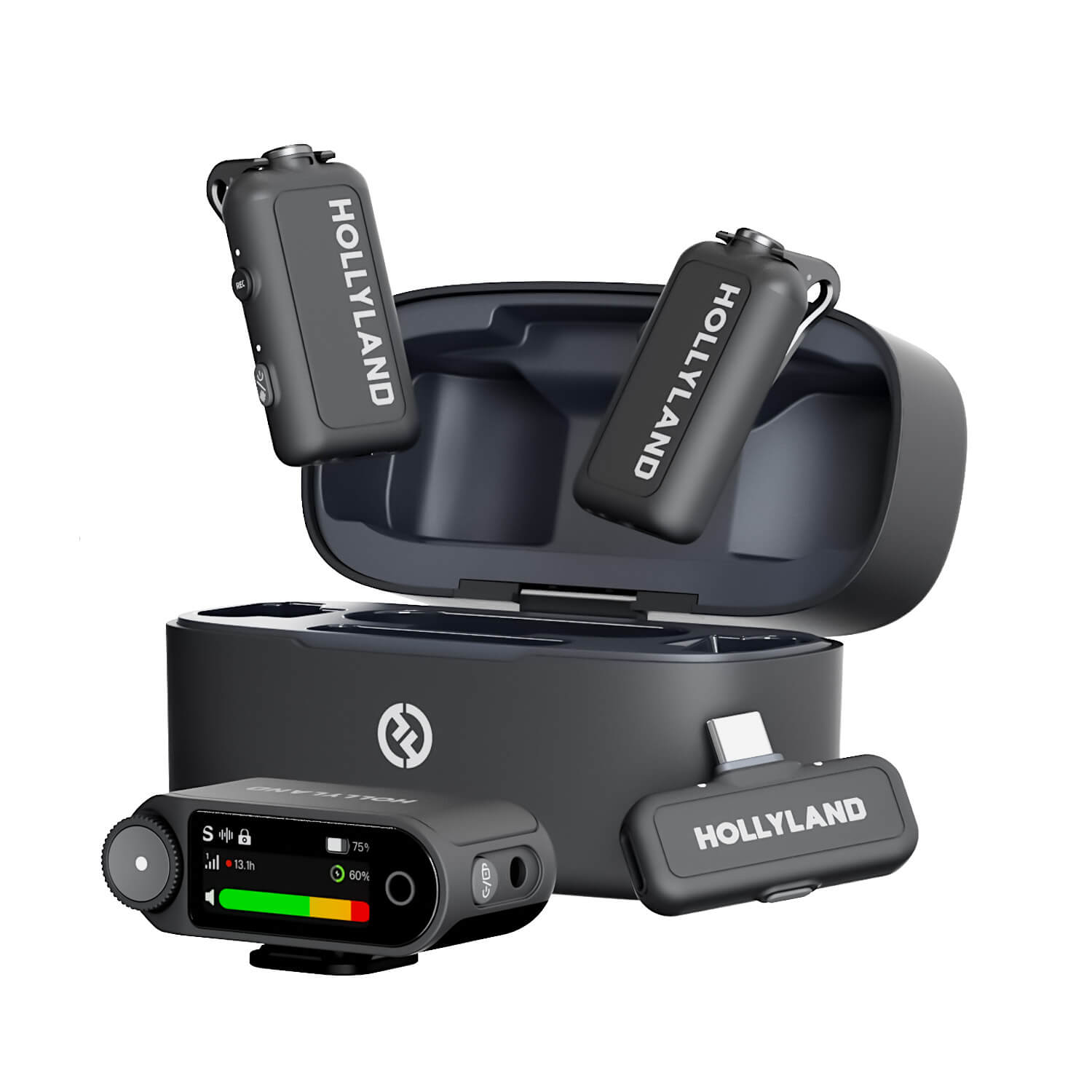

Hollyland LARK MAX 2 - Premium Wireless Microphone System
A premium wireless microphone for videographers, podcasters, and content creators to capture broadcast-quality sound.
Key Features: Wireless Audio Monitoring | 32-bit Float | Timecode
Read the full Hollyland Lark Max 2 Review for more details.
Specifications:
Polar pattern: Omnidirectional
Frequency response: 20Hz – 20kHz
Max SPL: 128dB
Connector: USB-C/3.5mm
Battery life: Approx. 11 hours
Transmission range: 340m
Pros:
- Touchscreen LED display for quick control
- Timecode sync makes post-production a breeze
- Universal connectivity with phone, camera, and laptop
- Wireless monitoring through camera or OWS earphones (sold separately)
- Compatible hotshoe adapter for Sony cameras (no messy cables)
Cons:
- The receiver UI can be a bit complex for on-the-fly tweaks
Suitable for: Filmmakers, documentary crews, event videographers, corporate shoots, interviews, field journalists, vlog duos, professional videographers, YouTubers
Price: Not specified
MADE For Creators: Hollyland Lark Max 2 Review – YouTube
2. Hollyland LARK A1 – Professional’s Favorite On‑the‑Go Mic

If you’re a creator who wants rich, clear recordings without all the bulky gear, the LARK A1 has you covered. The 3-level adaptive noise cancellation lets you cut through bustling cafés or windy rooftop shoots. Plus, with 6-level gain control, you’re in total control of your audio, dialing in the perfect level for every scene you record.

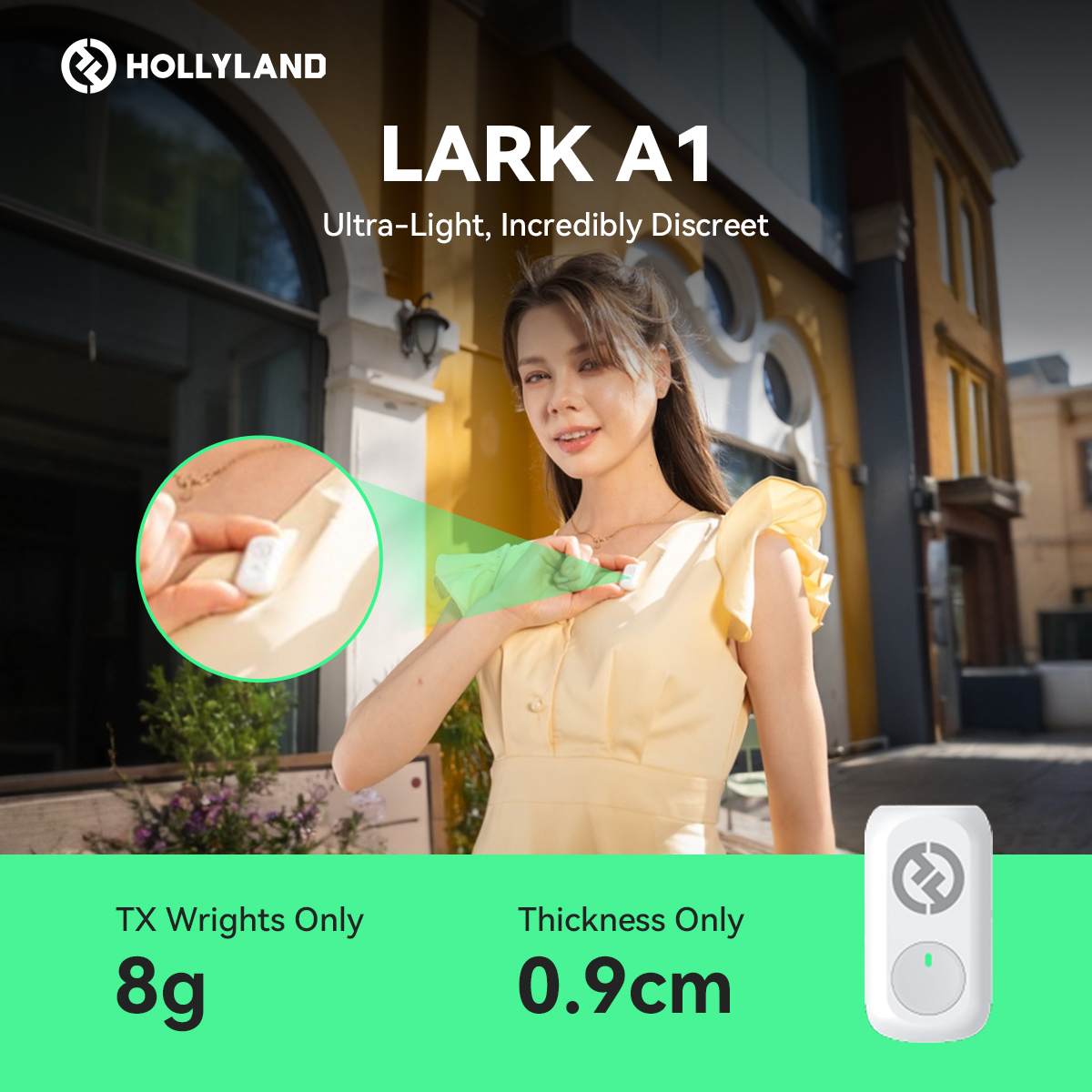
Hollyland LARK A1 - Affordable Wireless Microphone
A perfect starter mic for creators on a budget. It’s simple to use and features effective noise cancellation.
Key Features: 48kHz/24-bit | 3-Level Noise Cancellation | 54-Hour Battery
Read the full Hollyland Lark A1 Review for more details.
Specifications:
Polar pattern: Omnidirectional
Frequency response: 20Hz–20kHz
Max SPL: 120dB
Connector: USB-C/lightning
Battery life: Approx 9 hours
Transmission range: 200m
Pros:
- Ultra-light (8g) and slim (0.9cm)
- Auto-limit clip protection prevents distortion
- Comes with versatile presets for vocal tailoring
- The receiver allows pass-through charging to the phone
Cons:
- No internal recording
Suitable for: Podcasters, vloggers, multiperson interviewers, mobile content creators, field journalists, casual video making, interviews, corporate content producers, YouTubers
Real review from Amazon: Tiny little box that has all you need in one place. Nice to have lighting and usb c for whatever device you’re filming with — @Michael
Price: $69.90 (Combo)
I Tested the Hollyland Lark A1 – It BLEW Me Away! – YouTube
3. Hollyland LARK M2S – Logo-Free for Discreet Professionals

The Hollyland LARK M2S is a compact and lightweight microphone available in Lightning and USB-C versions for iPhones. It comes with a strong titanium clip that stays put, even during movement. Plus, the logo-free design makes it perfect for a more discreet setup on camera. Audio-wise, it’s rich and clear, with advanced ENC technology offering two levels of noise cancellation to keep your voice crisp.
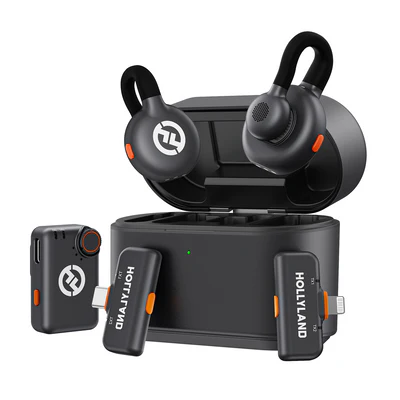
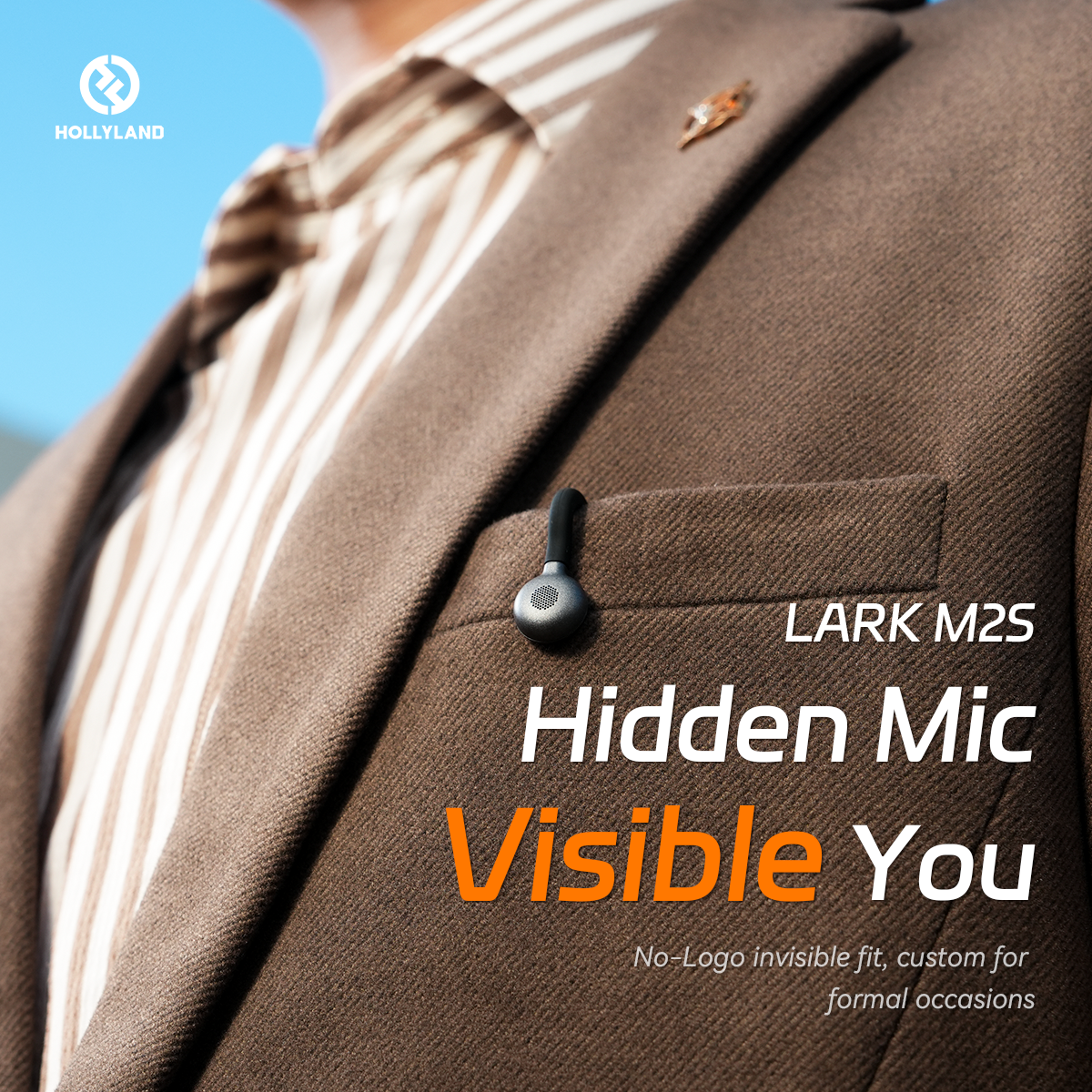
Hollyland LARK M2S - Wireless Hidden Microphone
An ultra-discreet wireless microphone featuring a clip-on transmitter for an “invisible” fit.
Key Features: No-Logo Fit | Ti+ Design | 48 kHz/24-bit
Read the full Hollyland Lark MS2 Review for more details.
Specifications:
Polar pattern: Omnidirectional
Frequency response: 20Hz–20kHz
Max SPL: 116dB
Connector: USB‑C/Lightning/3.5 mm
Battery life: Approx. 9 hours
Transmission range: 300m
Pros:
- Dual analog/digital output for versatile workflows
- App-configurable ENC with two noise-reduction levels
- Near-invisible design (no logos)
- RF-resistant for reliable performance in crowded wireless environments
Cons:
- Clip-only mounting
Suitable for: Filmmakers, interviewers, fitness instructors, event videographers, corporate presenters, documentary crews, professional videographers
Real review from Amazon: Great set of microphones. Works flawlessly on my iPhone and PC, I also use it for Discord/Gaming. Also great build quality, recommended! — @Saeverix
Price: $159 (Combo), ~$119 – $149 variants
Hollyland Lark M2S Review – The 7 gram Wonder! (2025 ) – YouTube
4. Hollyland LARK M2 – Versatile Button-Sized Microphone

The LARK M2 is another powerful, MFi-certified microphone by Hollyland that is shaped like a button. You can clip on, hang, or attach magnetically, making it a flexible solution for all kinds of recordings. The audio is rich and clear, thanks to 48 kHz/24-bit recording and strong noise cancellation.
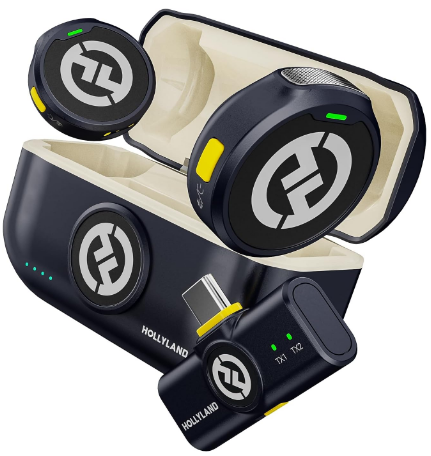

Hollyland LARK M2 - Mini Lavalier Microphone
An incredibly lightweight and compact wireless button microphone that captures high-fidelity audio.
Key Features: 9g Button Size | 48 kHz/24-bit | 40 Hours Battery
Read the full Hollyland Lark M2 Review for more details.
Specifications:
Polar pattern: Omnidirectional
Frequency response: 20Hz–20kHz
Max SPL: 115dB
Connector: USB-C/lightning/3.5mm TRS
Battery life: Approx 10 hours
Transmission range: 300m
Pros:
- Multi-device compatibility (cameras, phones, computers)
- Strong signal consistency via LDS antenna
- Intuitive knob for volume/recording mode adjustments
- Comes with the LarkSound app for precise control
Cons:
- No internal recording
Suitable for: Podcasters, YouTubers, multi-person video creators, field journalists, live streamers, filmmakers, vloggers, educational content creators
Real review from Amazon: Excellent and clean sound from these tiny mics, I bought the camera edition to use on my Sony A7s and the sound quality is really good, especially when using the noise canceling mode — @Moe A.
Price: $119 (Combo), ~$92–$106 variants
Hollyland Lark M2 – Long Term Review – YouTube
5. Hollyland LARK MAX – Big‑Stage Clarity in a Compact Dual‑Channel Package

The Hollyland LARK MAX provides top-notch audio clarity with its MaxTimbre technology. It puts you in control of your audio directly from the receiver through the headphone jack for real-time monitoring. It also features onboard recording and adaptive noise cancellation, which actually reduces background noise (even AC hum) without overprocessing your voice.
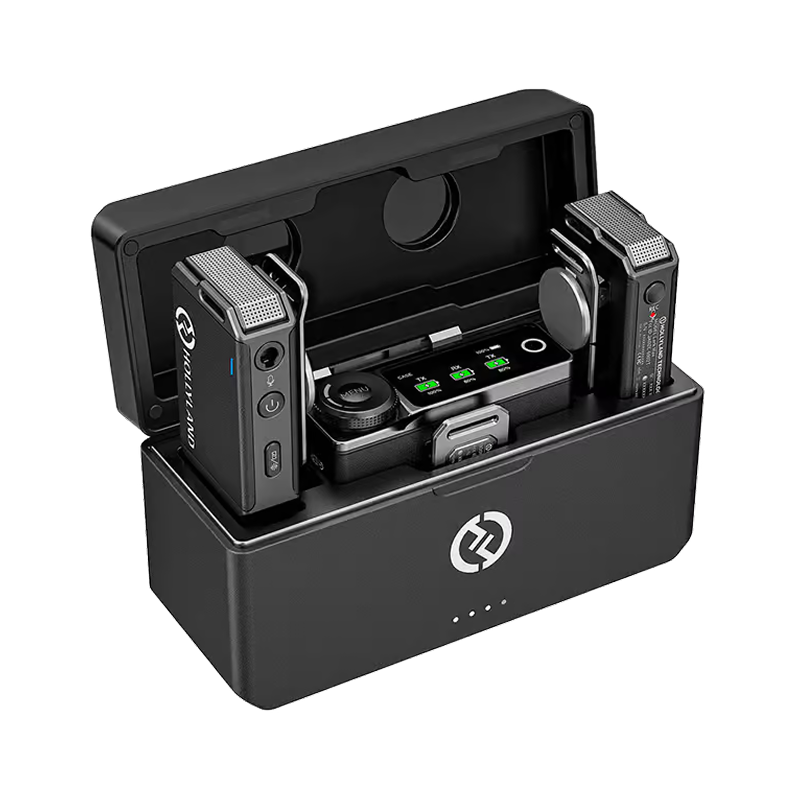

Hollyland LARK MAX - Professional Wireless Microphone
A professional wireless microphone system featuring studio-quality audio with advanced noise cancellation.
Key Features: Studio-Quality Audio | Magnetic Attachment | 8GB Internal Recording
Read the full Hollyland Lark MAX Review for more details.
Specifications:
Polar pattern: Omnidirectional
Frequency response: 20Hz–20kHz
Max SPL: 128dB
Connector: USB-C/3.5mm TRS
Battery life: Approx. 7.5 hours
Transmission range: 250m
Pros:
- Dual TX with independent safety-track backup
- Headphone output lets you live-monitor in real time
- Auto frequency hopping for a more stable signal
- Reliable internal recording (up to 14 hours per TX)
- Premium build with magnetic and clip-on options
Cons:
- A bit bulkier than other Lark models
Suitable for: Interviews, corporate content producers, event coverage teams, field journalists, podcasters, professional videographers, multi-person video creators, YouTubers
Real review from Amazon: Absolutely, beautiful set — unbelievable, extremely pleased!😊 — @Lenwood
Price: $102
Hollyland Lark Max – Best Wireless Mic of 2025? – YouTube
6. DJI Mic 2 – Smart, Reliable Audio with Post‑Production Flexibility

The DJI Mic 2 uses 32-bit float to avoid clipping and AI noise cancellation to cut through background chatter. That means you can concentrate on your content, not cleaning it up afterwards, which is perfect for tough recording scenarios.
Specifications:
Polar pattern: Omnidirectional
Frequency response: 50Hz–20kHz
Max SPL: 120dB
Connector: USB‑C, Lightning, 3.5 mm
Battery life: Approx. 6 hrs
Transmission range: 250m
Pros:
- AI noise reduction
- 32-bit float for distortion-free post-production
- Strong magnetic clip for secure placement
- Touchscreen receiver for intuitive controls
- 14 hours of internal recording
Cons:
- Case is bulkier than the previous version
- Higher upfront cost
Suitable for: Multi-interview podcasters, vloggers, field journalists, live streamers, YouTubers, corporate creators, filmmakers, education content, and interviews
Real review from Amazon: It’s very good, the sound quality is one of the best I’ve ever heard in this type of microphone. — @Erika
Price: $349 (Duo kit)
I Tested the DJI Mic 2 (it’s WEIRD) | Review – YouTube
7. DJI Mic 1 – Reliable Workhorse with Onboard Safety Track

The DJI Mic 1 remains a solid choice for its safety track recording (duplicate at -6dB) and universal compatibility with smartphones and cameras. With 8GB of internal storage (up to 14 hours of recordings), it lets you keep capturing without syncing immediately.
Specifications:
Polar pattern: Omnidirectional
Frequency response: 20Hz–20kHz
Max SPL: 114dB
Connector: USB‑C/Lightning/3.5 mm TRS
Battery life: Approx. 5.5 hrs
Transmission range: 250m
Pros:
- Compatible with hot and cold shoe adapters
- Safety track recording for backup
- Straightforward touchscreen controls
Cons:
- Mediocre battery life vs. newer models
- Magnetic mount is the only option
Suitable for: Podcasters, filmmakers, fitness trainers, casual vloggers, educational content, corporate content, influencers
Real review from Amazon: This mic set is phenomenal! The build quality, battery life, audio quality, functionality, and fit-n-finish are absolutely superior to anything else out there! — @Standing Goats
Price: $249
DJI MIC | Unboxing, First Impressions & Review! – YouTube
8. DJI Mic Mini – Extremely Discreet But Packs a Punch

The DJI Mic Mini trims down the standard DJI Mic design. It is small enough to disappear under a collar or lapel. Though it lacks internal backup recording and screen monitoring, it makes up for it with automatic limiting and two-tier noise reduction (basic/strong), letting your recordings stay clear and rich, even in busy or noisy spaces.
Specifications:
Polar pattern: Omnidirectional
Frequency response: 20Hz–20kHz
Max SPL: 120dB
Connector: USB-C
Battery life: Not Specified (48 hours case backup)
Transmission range: 400m
Pros:
- Featherweight and nearly invisible in shots
- Good audio limiting keeps speech clean
- Tiny size makes it nearly invisible in shots
- Have effective anti-interference transmission
Cons:
- Needs manual pairing with the receiver through the app
- No internal recording
Suitable for: TikTokers, mobile content creators, casual video making, educational videos, streamers, YouTubers, on-the-go interviews
Real review from Amazon: I use this for a lot of my videos, sound quality is sooo good. Definitely wasn’t expecting that much of a difference. Size is nice and compact. Functionality and use is easy. Simple plug and play. — @Caleb
Price: $169 (Duo kit)
DJI Mic Mini Review – The Best Budget Microphone in 2025! – YouTube
9. Rode Wireless Micro – Pocket-Friendly Clarity for Phone Creators

This compact dual-transmitter kit by RØDE sets itself apart with Intelligent Gain Assist, which automatically balances volume to avoid clipping during spontaneous recordings. Magnetic clips allow for a clean, wire-free setup, and 24-bit audio delivers crisp voice recordings—ideal for phone-first creators who need polished audio without a lot of fuss.
Specifications:
Polar pattern: Omnidirectional
Frequency response: 20Hz–20kHz
Max SPL: 135dB
Connector: USB-C/Lightning
Battery life: Approx. 7 hrs
Transmission range: 100m
Pros:
- Auto-leveling eliminates clipping risk
- Magnetic mounts for tidy, hidden placement
- Auto-pairing for zero setup delays
Cons:
- No onboard recording or safety track
- Limited compatibility — only above iPhone 14 and Android 11
- Shorter transmission range
Suitable for: Beginner podcasters, outdoor creators, TikTokers, YouTubers, casual vlogging
Real review from Amazon: Game Changer! Easy to use, travel friendly for a Podcaster on the go, the sound is very good, and eases post-editing as I use my phone for the video. — @Carole Neysmith
Price: $128
RODE Wireless Micro Honest Review! – YouTube
10. Godox WES2 – Budget-Friendly Dual-Channel Workhorse

The Godox WES2 sticks out with its slide-on windshield—great for windy shoots—plus selectable noise reduction onboard. In windy park tests, it turned unusable smartphone audio into broadcast-ready level, making it a smart, inexpensive upgrade if you’re into traveling or outdoor content creation..
Specifications:
Polar pattern: Omnidirectional
Frequency response: 20Hz–20kHz
Max SPL: 110dB
Connector: USB‑C
Battery life: 8 hours
Transmission range: 200m
Pros:
- Strong noise reduction options via mobile app
- MFi-certified for iPhone plug-and-play
- Dual-channel recording for interviews
- Good range for the price
Cons:
- Limited app compatibility with iPhone 15 and later
- No onboard recording, so backups are essential
Suitable for: Vloggers, educational video creators, mobile journalists, TikTokers, outdoor interviews, student filmmakers, field journalists
Real review from Amazon: These work really quite well. Good range. Nice sound. Would recommend at this price. — @KMS
Price: $99
Godox WEC Kit2 Review Wireless Clip On Microphone With Charging Case – YouTube
11. RODE Wireless PRO – Professional Broadcast Kit with Dynamic Noise Canceling

This one is RODE’s answer for pros. It delivers 32-bit float recordings for huge dynamic range. Another awesome feature is Timecode, which makes the post-production way more streamlined, especially for filmmakers working on multi-camera shoots.
Specifications:
Polar pattern: Omnidirectional
Frequency response: 20Hz–20kHz
Max SPL: 123.5dB
Connector: USB-C
Battery life: 7 hours
Transmission range: 260m
Pros:
- Timecode sync for seamless post-production
- 40 hours of onboard storage
- Studio-grade audio with minimal self-noise
- AI-assisted automatic volume adjustment
Cons:
- Heavier kit (about 458 g)
- More expensive than competitors
Suitable for: Filmmakers, multi-person video creators, event coverage teams, corporate content producers, field journalists, podcasters, professional videographers, interviewers
Real review from Amazon: I upgraded from the original Rode Wireless Go set-up, and the audio quality in these is fantastic. I use them regularly with clients for interviews and have yet to be disappointed. — @Chris Alvarez
Price: $369
Rode Wireless Pro – A REAL Review – YouTube
12. Shure MoviMic 88+ — Handheld Mic for Filmmakers

The Shure MoviMic 88+ is connects directly to an iPhone over Bluetooth via the Shure MOTIV app— no separate receiver required. It offers customizable polar patterns and numerous presets, letting you match your audio to different environments, whether you’re interviewing, recording a musical, or capturing nature sounds.
Specifications:
Polar pattern: Omnidirectional, stereo, mono cardioid, and mono bi-directional
Frequency response: 40Hz–18kHz
Max SPL: Not Specified
Connector: USB-C
Battery life: Approx. 8 hours
Transmission range: 30m
Pros:
- Compatible with third-party software like Zoom or Teams
- Allows customization of DSP settings
- Headphone monitoring for real-time audio checks
Cons:
- Custom directional settings can be a bit confusing
- Audio is more sensitive to weak noise-cancellation
Suitable for: Filmmakers, musicians, live interviewers, YouTubers, casual vloggers, corporate presenters, event coverage
Real review from Amazon: I had some doubts about how a little microphone like this could handle some loud jam sessions, but it surprised everyone. It’s very easy to use, including the Android app, and it sounds great. — @ Thundard
Price: $329
Shure MoveMic 88+ (Should You Buy it?)
13. RODE Wireless GO II – Versatile Field Companion

The Rode Wireless GO II stands out with flexible gain control starting from a 3-stage pad, expandable to 10, letting you fine-tune your audio to match any setting, from a bustling café to a silent studio. The safety channel is another handy feature, recording a backup track at a lower volume in case your main audio clips are lost.
Specifications:
Polar pattern: Bidirectional
Frequency response: 50Hz–20kHz
Max SPL: 120dB
Connector: USB-C/3.5mm
Battery life: 7 hours
Transmission range: 200m
Pros:
- 40 hours of onboard internal recording
- Excellent connection against RF interference
- LED display to show battery and connection status
Cons:
- Mono-based recording only
- Plastic build could be more durable
- Audio is very sensitive
Suitable for: YouTubers, live streamers, vlogging duos, corporate presenters, field journalists, multi-person video creators, educational content, event coverage
Real review from Amazon: Awesome mic! Great quality and very easy to use. I am so glad I went with this brand, I highly recommend it! — @ Erica A
Price: $156 (Single), $299 (Dual)
Rode Wireless Go 2 – Full Review (Audio & Range Test) – YouTube
14. BOYA Mini – Ultra-Compact Budget Performer

The BOYA Mini is another tiny mic on our list. It offers a 3-level noise cancellation and a voice changer, adding to its appeal for lightweight, flexible recordings.
Specifications:
Polar pattern: Omnidirectional
Frequency response: 20Hz–20kHz
Max SPL: Not Specified
Connector: USB-C/Lightning
Battery life: Approx. 6 hrs
Transmission range: 100m
Pros:
- Small and lightweight (31mm) for discreet placement
- 3-level noise cancellation with indicator
- Fast charging (5 minutes for a 1-hour recording)
- Automatic volume limiting to avoid distortion
Cons:
- No internal recording backup
- Voice changer is more of a gimmick
Suitable for: Travel vloggers, TikTok creators, journalists, educators, casual interviewers, live streamers
Real review from Amazon: I use these for our classroom and it works flawlessly. No more complaints about students hearing me from the mounted mic when I walk to the board for instruction. Charges via the case, mine is USB-C, so I had to use an adapter for my PC. — @ Richard/Annetta
Price: $59.99
The World’s Tiniest Wireless Mic – BOYA MINI (mini) Review – YouTube
15. MAONO WAVE T1 – USB Podcast Mic with Real‑Time Effects

This one’s a very powerful option if you want more control over audio. It offers 4 levels of noise cancellation and 8 AI voice filters and effects (e.g., “Radio” or “Podcast” presets), all adjustable through the Maono Link app. Meanwhile, the MFi-certified receiver guarantees a stable, high-fidelity connection to your iPhone.
Specifications:
Polar pattern: Omnidirectional
Frequency response: 20Hz–20kHz
Max SPL: Not Specified
Connector: USB-C/Lightning
Battery life: Approx. 6 hours
Transmission range: 100m
Pros:
- Studio-quality 48 kHz/16-bit audio with 32dB gain control
- Automatic limiting prevents clipping
- Charging case doubles as a power bank for the phone
- One-press noise cancellation
Cons:
- No internal recording
- Some range connectivity issues
Suitable for: Podcasters, office meetings, voice-over artists, educational content, corporate video, and remote presenters
Real review from Amazon: Had an issue with the receiver, and the customer support staff was excellent. Quick response, offered solutions, and finally a replacement of one faulty part. Couldn’t ask for better support, and the item works great too! — @Janet
Price: $26.99 (without case), $50.99 (with case)
Maono Wave T1 Mini Wireless Lav Mic | Sound Quality Demo | NICE and CHEAP! – YouTube
16. NEEWER CM28 – Budget Pro with Backup Recording

The NEEWER CM28 has a 2-channel, 16-bit recording, which gives nice, clear audio for interviews. It also doubles as a backup recorder with 4GB of internal storage in each transmitter. That lets you detach and record directly on the move, without needing a phone or camera.
Specifications:
Polar pattern: Unidirectional
Frequency response: 20Hz–20kHz
Max SPL: Not Specified
Connector: USB/3.5mm TRS
Battery life: Approx. 8 hrs
Transmission range: 200m
Pros:
- Records 9 hours internally as backup
- Full LCD screen & one-click noise cancellation
- Case charges mics 2x without external power
- Adapters for both Android and iOS
Cons:
- Occasional white-noise or connection hiccups
- Noise reduction sometimes dampens vocal tones
Suitable for: Solo interviews, budget filmmakers, student videographers, mobile creators, TikTokers
Real review from Amazon: These Lavs were worth the investment. Audio sounds clear, and this serves as a fantastic budget Lavalier. Even recording in windy conditions the audio was incredibly clear. — @Spencer Tracy
Price: $89.99 (mic set)
NEEWER CM28 WIRELESS LAVALIER MICROPHONE / MICS REVIEW – BUDGET DUAL MIC SYSTEM!!!!!
17. Mini Mic Pro – Influencer Approved Entry Level Mic

The Mini Mic Pro brings a lot of value to beginner creators who want a simple, reliable audio solution. It uses 2.4 GHz encrypted transmission for a stable, interference-free signal with minimal dropouts. Plus, the plug-and-play setup lets you connect quickly and start recording without a lengthy process.
Specifications:
Polar pattern: Omnidirectional
Frequency response: Not specified
Max SPL: Not Specified
Connector: USB-C/Lightning
Battery life: Approx. 6 hours
Transmission range: Not specified
Pros:
- Naturally rich audio with omnidirectional pickup
- Universal phone, PC, and camera connection
- Super-easy plug-and-play — no pairing needed
- Comes with wind protection accessories
Cons:
- Short transmission range (9-10m)
- Mediocre noise cancellation
Suitable for: Casual content creators, solo vlogs, influencers, YouTubers, gamers, TikTokers, educators, ASMR
Real review from Amazon: The product is great. It works plug and play, and both microphones simultaneously. I recommend the purchase. — @Samara Brochado
Price: $24.99
Is the Mini Mic Pro Really Worth Buying?
18. MOVO EDGE-DI-DUO – Battery-Free iOS Lavalier System

MOVO’s Edge-DI-DUO is exclusively available for iOS. It’s a dual-channel system with mono/stereo modes. The transmitters have onboard volume and gain adjustment, as well as headphone monitoring, which allows you to customise voice warmth on location. Overall, it’s a good fit for mid-level podcasting and interviews.
Specifications:
Polar pattern: Omnidirectional
Frequency response: 35Hz–14kHz
Max SPL: Not Specified
Connector: Lightning
Battery life: Not Specified (receiver draws phone power, transmitter uses 2 AAAA batteries)
Transmission range: 60m
Pros:
- Battery-free receiver, no charging hassles
- Support for two mics — perfect for interviews
- Durable hard case for storage
Cons:
- iOS-only, not for Android or USB-C
- May be susceptible to nearby Wifi interference
Suitable for: iPhone-based content creators, journalists, casual interviewers, educators, and vloggers
Real review from Amazon: For the price, this is a very useful piece of kit for aspiring videographers and content creators. I use it all the time for my YouTube channel. — @K.A
Price: $149
Movo Edge DI Duo Wireless Lavalier for iPhone Review + Demo
19. ZealSound USB Microphone – Budget Plug-and-Play Condenser

The ZealSound is the only corded microphone on our list, with a plug-and-play condenser mic that’s a convenient all-rounder for smartphones, consoles, and computers. It comes with all necessary adapters and lets you adjust gain or add effects directly on the mic.
Specifications:
Polar pattern: Unidirectional (cardioid)
Frequency response: 96Hz–96kHz
Max SPL: 125dB
Connector: USB-C/USB-A/Lightning
Battery life: N/A
Transmission range: N/A
Pros:
- Works with smartphones, consoles, and computers
- Built-in gain control for finer audio tweaks
- Tap-to-mute functionality
Cons:
- Background noise cancellation is weak
- RGB lighting isn’t customizable
Suitable for: Casual streamers, gamers, first-time content creators, podcasters, influencers
Real review from Amazon: This microphone works well and is easy to store away. The sound quality is great, and I’ve had no issues with any of the parts. Would recommend. — @Lucy
Price: $42.99
ZealSound USB Microphone Review/Demo
Conclusion
Choosing the best microphone for your iPhone comes down to identifying what matters most for your recordings. Look for key features like audio clarity, wireless range, battery life, and ease of use to match your needs. A lightweight, reliable, and adaptable mic can make all the difference in capturing rich, clear audio.
Also, choose well-reputed brands with a range of well-engineered options, like HollyView, to find the perfect fit for your iPhone.
FAQs
1. Do I need a special adapter if my iPhone has a USB-C port instead of a Lightning port?
It depends on your wireless mic’s connector. Some come with a USB-C receiver directly, while others use a Lightning plug. If you have a newer iPhone with USB-C, you’ll need a USB-C compatible receiver or a small Lightning-to-USB-C adapter.
2. How much latency should I expect when using a wireless mic with my iPhone?
High-quality wireless microphones have extremely low latencies, typically less than 20ms, which is nearly undetectable in video recordings. So your audio will stay in perfect sync with your video.
3. Will a wireless mic drain my phone’s battery?
Using a wireless mic typically draws a small amount of power from your phone (since the receiver is attached), but it’s not enough to drain your phone quickly. Still, for extended recordings, it’s a good idea to start with a fully charged phone or carry a power bank just in case, or opt for models with built-in batteries in receivers.
4. Do I need a special app to use a wireless mic with my iPhone?
It depends on the mic. Most wireless microphones come with onboard controls — such as gain and EQ — that allow you to adjust the audio directly on the transmitter or receiver. They typically work smoothly with your iPhone’s native camera or audio apps. However, some professional models offer a companion app that unlocks finer control over settings, allowing you to customize audio profiles, activate low-cut filters, or adjust stereo and multichannel modes for greater flexibility.

































.png)




